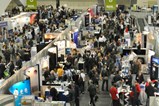Large BiOS Program Feeds SPIE Photonics West Growth Trend

The BiOS technical program at SPIE Photonics West in January -- once again the largest of the event's four symposia -- is helping to draw more exhibiting companies than ever to the BiOS Expo on opening weekend. Technical topics include enabling technologies for applications such as treatments for cancer, stroke, epilepsy, vision loss, and much more.
Photonics West runs 21-26 January at the Moscone Center in San Francisco, California. On a continuing growth trend, the event is the world's largest international conference and exhibition on industrial and medical applications of optics, lasers, and photonics. Total attendance is expected to top 19,000 during the Photonics West week.
The BiOS -- biomedical optics -- technical program includes nearly 1,800 technical presentations in tracks on photonic therapeutics and diagnostics; clinical technologies and systems; tissue optics, laser-tissue interaction, and tissue engineering; biomedical spectroscopy, microscopy, and imaging; and nano/biophotonics.
A new conference has been added this year on Optical Techniques in Pulmonary Medicine, and sessions on optogenetics have been added to conferences on Photons and Neurons and on Optical Biopsy.
The extensive set of courses and workshops at Photonics West includes BiOS-related topics such as microscopy, optical coherence tomography, and tissue optics.
The BiOS Expo runs 21-22 January. Product demonstrations and new product announcements are scheduled both days. The number of exhibiting companies is up more than 15% over last year, and is expected to reach 195.
Hot topics
Featured sessions will begin with the popular BiOS Hot Topics session facilitated by Sergio Fantini (Tufts Univ.) on Saturday night. Speakers and topics include:
- Daniel Palanker (Stanford Univ.), " Photovoltaic retinal prosthesis for restoring sight to the blind"
- Brian Wong (Beckman Laser Institute, Univ. of California, Irvine), "Emerging applications for optical coherence tomography in the head, neck, and upper airway"
- Adam Wax (Duke Univ.), "Early cancer detection with coherence imaging"
- Xingde Li (Johns Hopkins Univ.), "Scanning fiber optic nonlinear endomicroscopy"
- Stephen Boppart (Univ. of Illinois/Urbana Champaign), "Coherence imaging of cancer with novel optical sources"
- Vasilis Ntziachristos (Technical Univ. Munich), "Advances in fluorescence and opto-acoustic imaging"
- Elizabeth Hillman (Columbia Univ.), "In-vivo microscopy: a new window on the brain"
- Seok Hyun Yun (Harvard Univ. and Massachusetts General Hospital), "Bio laser."
W. E. Moerner (Stanford Univ.), plenary speaker in the Nano/Biophotonics track, will discuss "Single-molecule active control microscopy for nanoscale 3D cell images."
- Robin Ali (Univ. College London), "Biological engineering of retinal disease: needs for technology" (8209-12)
- Warren Warren (Duke Univ.), "Pump-probe imaging of melanoma" (8220-7)
- Karl Deisseroth (Stanford Univ.), "Advances in optogenetics" (8220-22)
- Stefan Hell (Max-Planck-Institut für biophysikalische Chemie), "Nanoscopy with focused light" (8228-23)
- Ashok Kumar Mishra (Indian Institute of Technology Madras), "Excited-state prototropism-based fluorescent molecular probes for lipid bilayer membranes" (8233-10)
- Tayyaba Hasan (Wellman Ctr. for Photomedicine), "Targeting drug resistance mechanism for a rapid optical identification of specific antibiotic utility: photosensitizers as multifunctional molecular probes" (8233-1).
James Fujimoto (Massachusetts Institute of Technology) and R. Rox Anderson (Massachusetts General Hospital and Harvard School of Medicine) cochair the BiOS symposium.
Complete program details are on the event website, http://spie.org/bios.
Entrepreneurs and innovation
The Entrepreneurship Start-up Challenge will return to Photonics West with Biophotonics and Optoelectronics divisions, giving young researchers an opportunity to pitch their products or small-business start-up ideas to a panel of experts and entrepreneurs. Jenoptik is joining SPIE in sponsoring this year's challenge. Top presenters will be sponsored to attend the highly rated Entrepreneurship Academy at the University of California, Davis.
The 2011-12 Prism Awards for Photonics Innovation will be presented by SPIE and Photonics Media at a gala banquet during SPIE Photonics West. The international competition recognizes cutting-edge products that break conventional ideas, solve problems, and improve life through photonics.
Ocean Optics and SPIE will present a panel of Blue Ocean open-innovation grant winners, to discuss the entrepreneurial process and approaches to activities such as networking, training, and planning.
The Photonics West exhibition, with more than 1,150 exhibiting companies, will run mid-week, 24-26 January. Features include numerous new product announcements, international pavilions from several countries, booths from photonics clusters from several U.S. states, product demonstrations, and the SPIE Job Fair.
A total of 4,220 papers are scheduled in the four Photonics West symposia, BiOS, Lasers (LASE), MOEM/MEMS, and Optoelectronics (OPTO).
Accepted papers will be published in the SPIE Digital Library as soon as approved after the meeting, and in print volumes and digital collections.
About SPIE
SPIE, the international society for optics and photonics, was founded in 1955 to advance light-based technologies. Serving more than 180,000 constituents from 168 countries, the Society advances emerging technologies through interdisciplinary information exchange, continuing education, publications, patent precedent, and career and professional growth. SPIE annually organizes and sponsors approximately 25 major technical forums, exhibitions, and education programs in North America, Europe, Asia, and the South Pacific. SPIE provided over $2.3M in support of education and outreach programs in 2010.
SOURCE: SPIE
